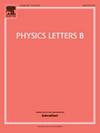非线性带电Brans-Dicke-BTZ黑洞热力学
IF 4.3
2区 物理与天体物理
Q1 ASTRONOMY & ASTROPHYSICS
引用次数: 0
摘要
研究了三维(3D)时空中与功率-麦克斯韦非线性电动力学(NLED)耦合的新型bransdike (BD)黑洞(BHs)的热力学性质。Jordan框架BD场方程是非线性的,过于复杂,难以解析求解。我们通过使用共形变换(CT)将BD作用转化为爱因斯坦坐标系来解决这个问题。在爱因斯坦的框架中,理论是著名的爱因斯坦膨胀引力,场方程是解耦的,更容易求解。我们用指数反萨兹函数解决了爱因斯坦幂-麦克斯韦膨胀理论中出现的数学不确定性问题。然后,通过精确求解场方程,我们引入了两类具有异常渐近线的新型三维EPMd黑洞。我们计算了守恒量和热力学量,以证实黑洞热力学第一定律的有效性,并分析了EPMd黑洞的热稳定性。通过应用逆CT,我们引入了与爱因斯坦坐标系对应的三维BD-Power-Maxwell (BDPM)黑洞。通过使用这些图,我们证明了我们的Jordan框架解可以产生无视界、单视界和双视界黑洞。我们证明了在两个共形相关坐标系中热力学量是相同的,并得出它们是共形不变的结论。基于这种对称性,FLT对BDPM黑洞仍然有效,并且它们表现出与EPMd黑洞相似的稳定性。本文章由计算机程序翻译,如有差异,请以英文原文为准。
Thermodynamics of nonlinear charged Brans-Dicke-BTZ black holes
We studied the thermodynamic properties of novel Brans-Dicke (BD) black holes (BHs) coupled to power-Maxwell nonlinear electrodynamics (NLED) in a three-dimensional (3D) spacetime. The Jordan frame BD field equations are nonlinear and too complex for analytic solving. We removed this problem by using the conformal transformations (CT) which translate the BD action to the Einstein frame. In the Einstein frame, where the theory is the well-known Einstein-dilaton gravity, the field equations are decoupled and easier to solve. We solved the problem of mathematical indeterminacy, that appeared in the Einstein-power-Maxwell-dilaton (EPMd) theory, by using an exponential ansatz function. Then, by exactly solving the field equations, we introduced two novel classes of 3D EPMd BHs with unusual asymptotes. We calculated the conserved and thermodynamic quantities to confirm the validity of the first law of BH thermodynamics (FLT) and to analyze the thermal stability of the EPMd BHs. By applying the inverse CT, we introduced 3D BD-Power-Maxwell (BDPM) BHs corresponding to the Einstein frame counterpart. By using the plots, we showed that our Jordan frame solutions can produce horizon-less, one-horizon, and two-horizon BHs. We proved that thermodynamic quantities are the same in both conformally related frames and concluded they are conformal-invariant. Based on this symmetry property, the FLT remains valid for the BDPM BHs, and they exhibit similar stability properties as the EPMd ones.
求助全文
通过发布文献求助,成功后即可免费获取论文全文。
去求助
来源期刊

Physics Letters B
物理-物理:综合
CiteScore
9.10
自引率
6.80%
发文量
647
审稿时长
3 months
期刊介绍:
Physics Letters B ensures the rapid publication of important new results in particle physics, nuclear physics and cosmology. Specialized editors are responsible for contributions in experimental nuclear physics, theoretical nuclear physics, experimental high-energy physics, theoretical high-energy physics, and astrophysics.
 求助内容:
求助内容: 应助结果提醒方式:
应助结果提醒方式:


